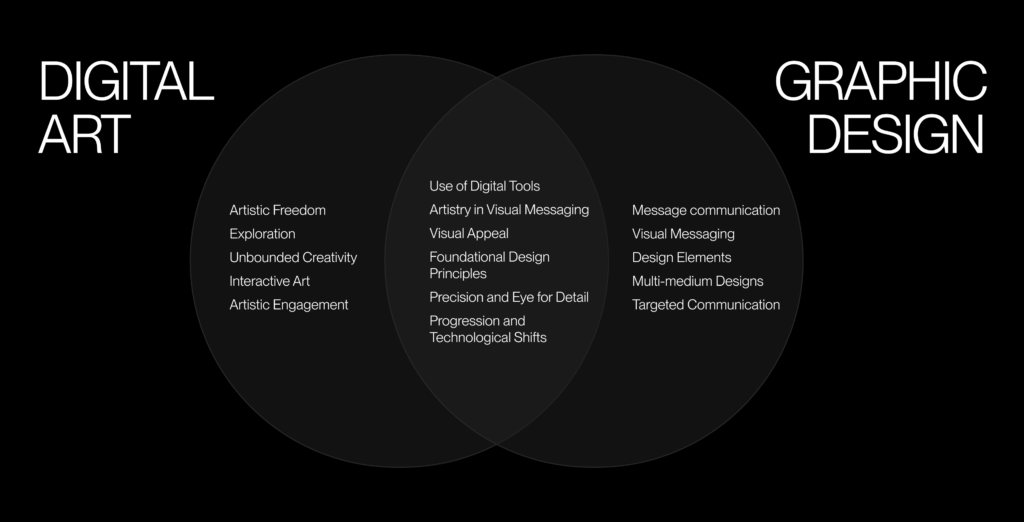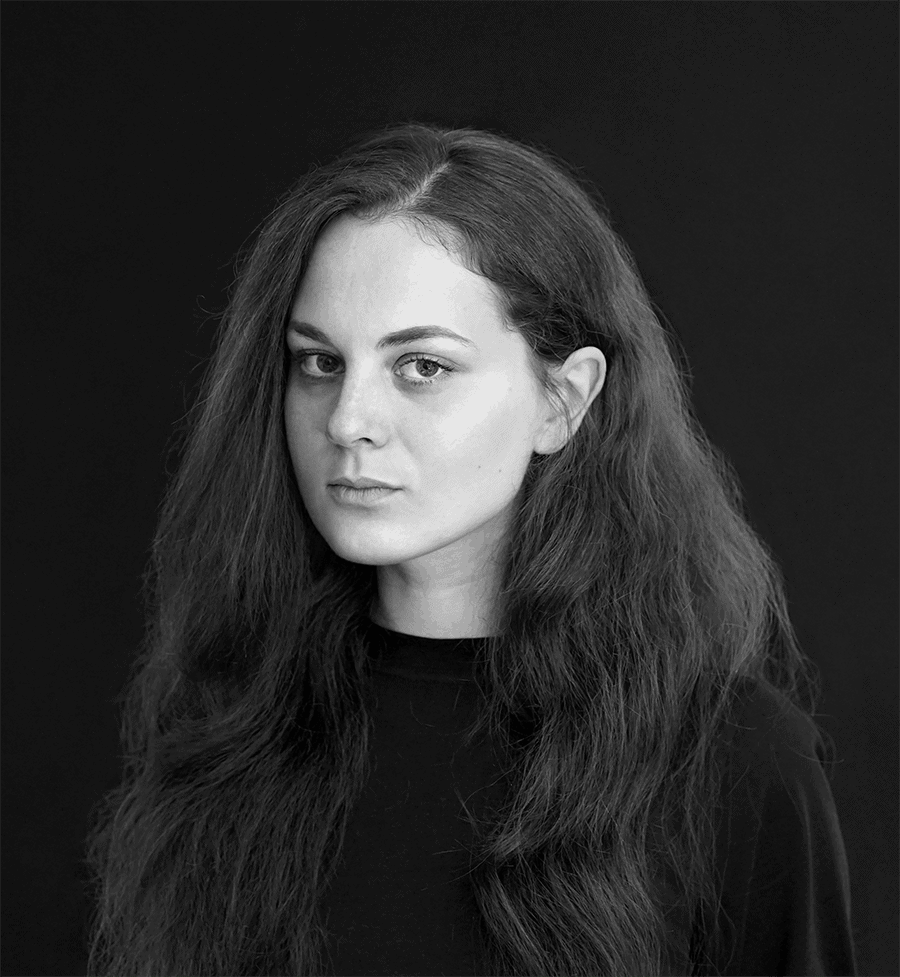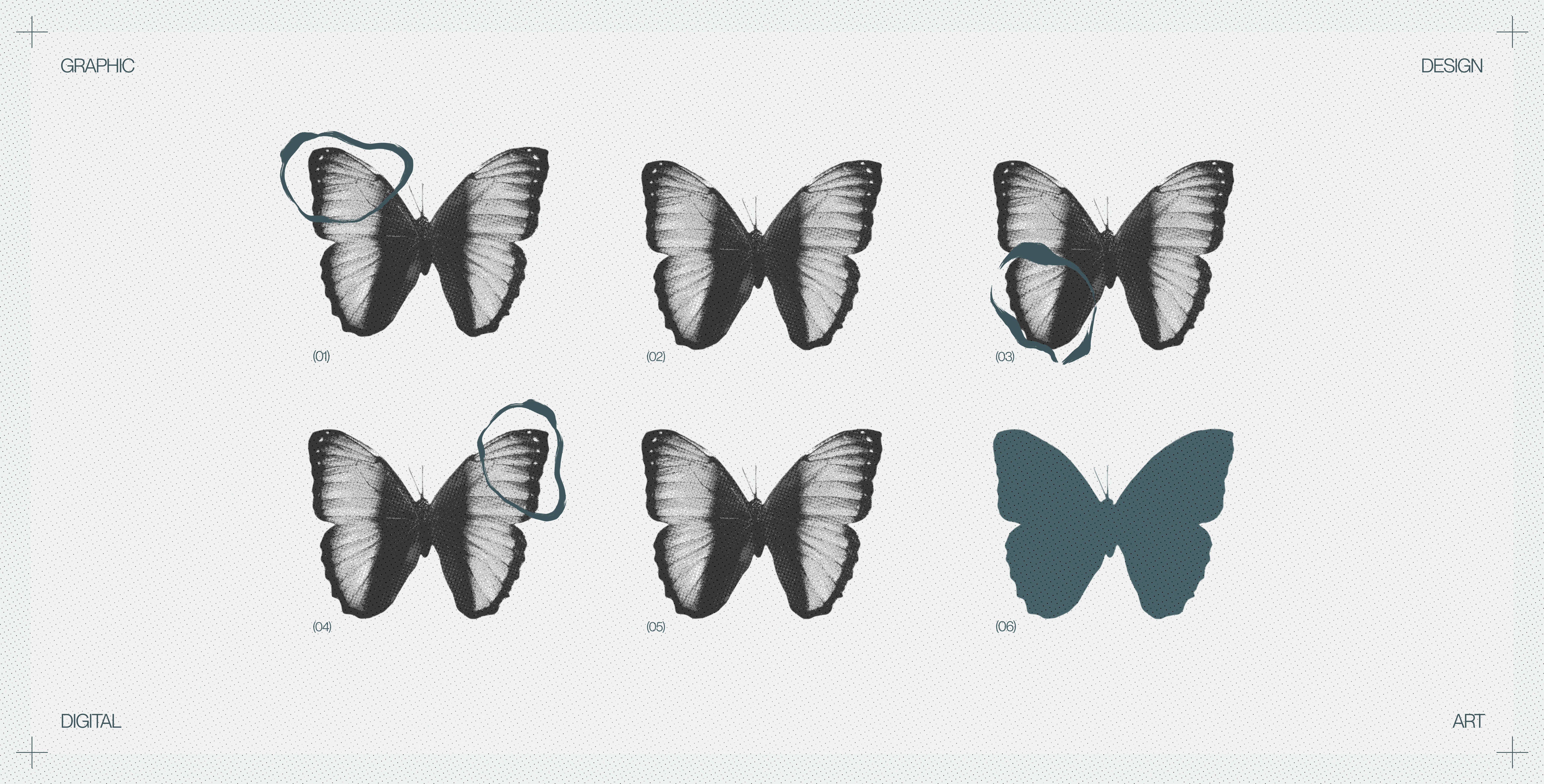Outline:
Imagine walking into an art gallery and stumbling upon a piece that catches your eye—not because of its traditional strokes or sculpted forms, but due to its vivid manipulation of digital elements. This is digital art.
Now, consider receiving a beautifully designed flier for an upcoming event; it communicates effectively, its purpose clear and aesthetics pleasing. This is graphic design.
While both realms harness visual components, their underlying intentions and audience engagements often set them on seemingly divergent paths. Yet, as we dive deeper into graphic design vs digital art exploration, we find that the boundaries blur and their intersections become more pronounced.
This exploration aims to demystify and differentiate digital art from graphic design, shedding light on their unique features while highlighting their ever-growing convergence. Also, we will provide everything you need to know about graphic design and digital art, equipping you with all the essential knowledge to confidently navigate and understand these creative fields.
Historical Context and Evolution
Graphic and digital design have rich histories that mirror the advancement of technology. Before we discover their unique features, let’s delve into how each field has evolved from its roots to the present.
Origins of Graphic Design
Graphic design’s lineage can be traced back to ancient hieroglyphs and medieval manuscripts, but its modern form took shape with the advent of print technology. The Industrial Revolution propelled graphic design forward, morphing it into a crucial tool for mass communication.
As digital technologies emerged, graphic design expanded its reach and capabilities, blurring the lines between traditional and digital mediums. Today, it encompasses everything from web design to branding, often intertwining techniques traditionally associated with digital art.
Development of Digital Art
Digital art, unlike graphic design, is born purely from technological innovation. It began as an experimental form that utilized the burgeoning capabilities of computing in the 1960s and 1970s. As technology advanced, so did the complexity and popularity of digital art. Today, it encompasses a vast range of practices, including digital painting, 3D modeling, and interactive installations, often pushing the boundaries of how art is defined and consumed.
While graphic design and digital art originated from different historical contexts, their evolution has been dramatically influenced by technology. This shared digital lineage has not only equipped artists and designers with similar tools but has also fostered a shared conceptual space where once distinct practices now frequently overlap.
What Is Graphic Design
Graphic design is a craft where professionals create visual content to communicate messages. By applying visual hierarchy and page layout techniques, designers use typography and pictures to meet specific needs of users and focus on the logic of displaying elements in interactive designs to optimize the user experience. This discipline revolves around the ability to convey a message through visual elements effectively.
Principles of Graphic Design
Fundamental principles guide graphic designers in creating effective and aesthetically pleasing visuals. These principles include:
- Balance: Creates stability and structure in the design.
- Alignment: Ensures a sharper, more organized appearance.
- Repetition: Strengthens the design by tying together consistent elements.
- Contrast: Draws out key features and enhances readability.
- Hierarchy: Guides the viewer through the design by showing them where to focus first.
Tools of Graphic Design
Graphic designers rely on a robust toolkit to bring their creative visions to life. Key software includes:
- Adobe Photoshop: Essential for image editing and creating complex photo-based illustrations.
- Adobe Illustrator: Ideal for creating vector-based graphics and illustrations.
- Adobe InDesign: Used primarily for layout design of brochures, magazines, and more.
These tools are standard in the industry, helping designers execute high-level projects with precision.
Examples of Successful Graphic Design
Recognizable graphic design services New York can be seen in iconic logos and advertising campaigns. For instance:
Apple’s Logo
Simple yet effective, this logo uses minimalism to convey sophistication and innovation.

Coca-Cola’s Holiday Campaigns
These often feature heartwarming graphics that enhance brand recognition and emotional connection.

RCAD Project by Ester Digital
Our approach to the RCAD branding merged geometric precision with a modern aesthetic. The logo, integrating an abstract form of the letter “R” into a wordmark, reflects innovation while maintaining simplicity and clarity. This project not only reinforced RCAD’s identity but also highlighted our commitment to creating distinctive and purposeful design solutions.

What Is Digital Art
Digital art is an artistic work that incorporates digital technology during the creation process. It represents an artistic transition from traditional techniques like painting and drawing to digital implementations, which can include animations, digital paintings, and projects that combine various multimedia elements including sound and motion.
Tools of Digital Art
Digital artists have access to a variety of tools that cater to extensive creative freedom. Noteworthy among these are:
- Corel Painter: Known for its realistic brushes and painting experience, mimicking traditional media.
- Adobe Photoshop: While known for photo editing, it’s also powerful for creating complex digital artworks.
- Blender: An open-source 3D modeling tool that is crucial for creating animated films, visual effects, art, 3D printed models, and interactive 3D applications.
Examples of Digital Art Projects
Some digital art projects have gained notoriety for their innovative approach and cultural impact. Examples include:
“The Next Rembrandt”
A project that used data from Rembrandt’s paintings to create a new artwork, showcasing how AI can emulate classic artistic techniques.

Radiohead’s “House of Cards” Music Video
Utilized real-time 3D recording and visual data without cameras, instead employing structured light to capture detailed images, pushing the boundaries of digital art and music video production.

Defining and Distinguishing: Graphic Design vs Digital Art
As we understand their histories and distinctive features, let’s explore what fundamentally separates and connects these two creative fields.
Core Practices of Graphic Design
Graphic design is fundamentally about communication. Its primary goal is to inform, persuade, and engage audiences through visual media. This could be seen in the corporate branding of a tech giant, where a logo design encapsulates the essence of the company, or in the layout of a website that guides a user effortlessly through information. The strategic placement of images, choice of colors, and typeface selection are all meticulously planned to achieve a specific interaction with the audience.
What Is Digital Design
In contrast, digital design is an exploration of artistic expression through digital means. It is not confined by the commercial needs or strict guidelines that often shape graphic design. For example, a digital painter might use a tablet and stylus to create artworks that evoke emotion or provoke thought, unrestricted by client demands. This form of art is more about the artist’s vision and message, transforming traditional painting into a digital format that allows for new textures, techniques, and experiences.
Digital Art vs Graphic Design: A Comparison
Though they share some tools and techniques, the core goals of digital art and graphic design are distinct. Graphic design’s main objective is to solve communication problems, effectively conveying a message to an audience, often with commercial intent. Conversely, digital art focuses on pushing the boundaries of the digital medium to explore artistic expression, often without commercial constraints. This freedom allows digital artists to experiment with form and content, resulting in works that might not have direct applications but offer significant artistic and cultural value.

Despite these inherent differences, the line between graphic design and digital art frequently blurs as practitioners in each field draw on techniques and tools from the other to enhance their work, leading to innovative creations that defy easy categorization.
Cross-Disciplinary Techniques and Innovation
With the lines blurring, let’s examine how graphic and digital design not only share techniques but also innovate together, creating new pathways for creativity and interaction.
Shared Techniques
The toolbox of digital artists and graphic designers often overlaps, with software like Photoshop and Illustrator serving dual purposes. For example, vector graphics—a staple in graphic design for creating logos and illustrations—are equally vital in digital art for their scalability and precision. Similarly, color theory principles apply across both fields, ensuring visual harmony and enhancing the viewer’s experience.
Innovative Overlaps
Emerging technologies such as virtual reality and augmented reality are finding their way into both fields, offering new ways for creators to engage with audiences. Graphic designers are increasingly using VR to create immersive brand experiences, while digital artists employ AR to bring interactive dimensions to their artworks, allowing viewers to experience art beyond traditional galleries.
Professional and Cultural Impact
As technology redefines the tools and techniques of both fields, it also reshapes the roles of those who wield them and the cultural contexts in which they operate. Let’s explore how graphic and digital design influence professional practices and cultural expressions.
Blended Roles
The digital age has catalyzed a fusion of roles within the creative industries. Today’s professionals often navigate the realms of both graphic design and digital art, embodying the skills and sensibilities required in each discipline. This blending of roles is evident in careers where designers must create both appealing commercial content and engage in pure artistic endeavors. The ability to switch between designing for function and creating for expression has become a valuable asset in the digital landscape.
Cultural Influence
Graphic design and digital art do more than just reflect societal trends; they actively shape them. Through mediums such as advertising, digital installations, and interactive web interfaces, these fields contribute to the cultural dialogue, influencing everything from consumer behavior to aesthetic preferences. They not only mirror the current cultural ethos but also push the envelope by introducing new concepts and challenging existing perceptions.
Thus, as graphic and digital design continue to evolve, their impact on professional identities and cultural norms deepens, blurring not just the lines between disciplines but also between the creators and their audiences.
Future Directions and Collaborative Potential
Looking to the horizon, the intersections of digital art and graphic design hold promising potential for innovation and collaboration. Let’s examine some of the trends and collaborative projects that could shape the future of these creative fields.
The future of graphic design and digital art appears increasingly intertwined with developments in AI, machine learning, and immersive technologies. These tools are not only expanding the capabilities of artists and designers but also creating new spaces for collaboration. For example, AI-driven algorithms can now assist in creating complex designs and artworks, enabling creators to explore new creative processes that were previously unimaginable.
One of the most exciting aspects of the convergence between digital art and graphic design is the potential for collaborative projects that merge aesthetics, functionality, and technology. Projects like interactive advertising campaigns and virtual reality art exhibitions showcase how combining these disciplines can result in extraordinary experiences. Such collaborations not only enhance the visual and functional appeal of a project but also engage audiences in ways that were once beyond reach.
These innovative collaborations are not just pushing creative boundaries but are also setting new standards for what can be achieved when art and design intersect in the digital realm.
On a Final Note
Throughout this journey, we’ve seen how digital art and graphic design, though springing from different roots, are drawing ever closer together. This merging is more than a demonstration of their adaptability—it’s a showcase of the limitless creativity that flourishes when we blur the lines between disciplines.
As these fields continue to blend, it’s crucial for both seasoned professionals and passionate enthusiasts to recognize and value the distinct contributions each brings. More importantly, we should all consider the exciting possibilities that arise from their collaboration. By embracing this evolving landscape, we not only enrich these fields but also broaden what can be achieved with digital creativity.
Interested in exploring how you can contribute to or benefit from this dynamic field? Don’t hesitate to contact us. We’re here to guide you through this exciting territory and help you uncover new opportunities that await in worlds of graphic design and digital art.





